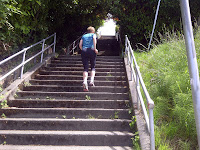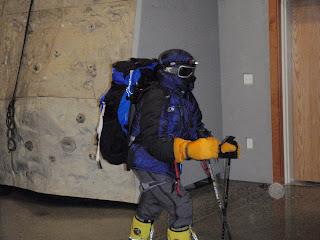I was feeling strong as I lifted my backpack out of the overhead luggage stow. It was full of the absolute necessary gear for the trek that I knew I couldn't replace if my boundary bag got lost. I wore my comfortably worn mountaineering boots, carried my medications, cameras, favorite mountain snacks, technical layers and my alpine down coat. I had taken 2 liters of water on board in Washington DC and had managed to drink almost all the water I had carried onboard plus the drinks served every few hours by the airline attendants. Dehydration will greatly limit performance on the mountain and lead to problems with altitude including fatigue, headache and muscle cramps, none of which can be tolerated on the mountain and can mimick acute mountain sickness. I had closely monitored my water intake for a month before the climb drinking more than thirst called for. Once arriving in country for the climb, it would be even more important to make sure enough water is consumed. It would be impossible to get fully hydrated if you start a climb dehydrated since the body needs time to distribute and equilibrate the body's water over several days.
The workouts had continued up to the day before leaving for Africa yet I wondered if I had trained hard enough. But it was too late now to worry about whether I was fit enough. I thought of the team whom I would meet in a couple more days. I wasn't sure about a lot of things, all I knew once stepping onto the Kilimanjaro tarmack is that Monique and I were there for a bigger purpose than pursuing our own climbing aspirations.
We made it through customs with no problems. We exited the terminal to find our guide and porters waiting for us with a Bushbuck Safari jeep. As the porter and guide loaded the jeep with our boundary bags, we headed back to the washroom. We had to remember, no tap water can be consumed or even splashed into the eyes. This is challenging coming from the States where tap water is never given a second thought. I tipped the porter at JRO and our driver both $5 usa. I later learn this would be a tip for a whole day of service. All six of us piled into the jeep. The interior of the jeep was comfortable, seating enough for 10. We were off and moving closer to our objective.
The road to Arusha has two lanes. Cars, trucks, motorcycles and bicycles used whatever lane was open. Oncoming traffic was nerve racking. In Kentucky we call this form of driving playing 'chicken'. It was Sunday and many people were out at church gatherings and walking alongside the road in their Sunday attire. I was amazed at the colorful fabrics of red, purple and blue. The women dressed in beautiful layers of flowing color. The color was strikingly beautiful. In the States, clothing styles are driven by the best marketing companies where in Tanzania, the clothing is beautiful and practical. I find most American clothing monochromatic in nature where everyone looks the same. Women were carrying objects on their heads leaving their hands to carry even more. Children were also carried, bundled on the front or back. I could imagine these women could easily climb a mountain. I also thought they could easily outwork any man I know in the States.
There were many more people walking along the road than driving. The road was lined by small herds of cattle and goats and a few herdsman. We passed small diners along the way with dirt parking lots full of motorcycles. Coca Cola was the predominant advertisement with several red and white awnings and chairs displaying the familiar logo.
It was almost an hour to get to the Arusha Hotel. We were greeted by Ben Johnson, our Alpine Ascents guide. What a nice looking guy and very soft spoken. Ben made sure the check in process went well and told us we would meet tomorrow morning at 9:30am with Eric Murphy, our lead guide for a short meeting before we headed into town for sightseeing. So far, the trip coordination was just as promised by Alpine Ascents.
Our room was very adequate and clean. The hot water pot was a nice addition since it could boil water. Our room overlooked the inner lawn and dinning room. The inner lawn was full of palm trees, flowers, and a manicured lawn with a central walkway leading to the pool. It looked like it would rain at any moment and the air was a cool 65 degrees. Arusha is at just over 4,000 feet elevation. Of course the temperature would be cooler, even though we were close to the equator. I had looked at the projected weather for Kilimanjaro before leaving Seattle. I was surprised to see the weather was very much like Seattle weather and we should have clear skies and a full moon for our climb.
I was anxious to open up the bags to make sure all the gear made it seeing as you can't lock the Sealine Boundary bags. We opened our boundary bags to find they had been searched. Some of my gear was in Monique's bag and some of hers in mine. It's a wonder nothing was taken or lost and thankfully we were traveling together. We unpacked and separated our climbing items from the safari items and repacked the boundary bag for the climb only. The safari bag would remain at the hotel while we were on the mountain. Gear is all there, now time to eat.
Ben asked us not to sleep until the evening to help with jet lag. Stay up and go to sleep at your normal bedtime. That would be very difficult considering the 10 hour difference. I was tired but also ready to go downstairs for lunch. We met John in the dining room and had a quick lunch. Martha, Nan and Doug had already eaten and retired to their rooms. The buffet lunch had really good Indian food, one of my favorites. We had pumpkin soup, pasta primavera, rice, potatoes and steamed vegetables. The coffee is the best I have had, ever. I live in the world of Starbucks but have never liked their coffee. People I meet are so surprised that I am not a Starbuck's fan and then they usually admit to disliking the bitterness of Starbucks as well. The coffee in Tanzania is very smooth while maintaining a rich flavor. We were just getting to know John, he is a really funny guy. My persistent yawning was telling me it was time to rest. We bought two three liter bottles of water from the waiter who added 5,000 shillings to our lunch tab. We were very focused on avoiding diarrhea while trying to still drink several liters of water a day. I picked up our bottled water and we were off to the room for a quick nap. |
| Sierra and John |
 |
| Porters, John and Martha |
 |
| John our Bushbuck driver |
 |
| Monique leaving for Tanzania from Ethiopia |
 |
| Monique ready to leave for Arusha |
 |
| Homestead on the way to Arusha |
 |
| Goat herd and homestead |
 |
| Small town on the way to Arusha |
 |
| Children at play on the way to Arusha |















